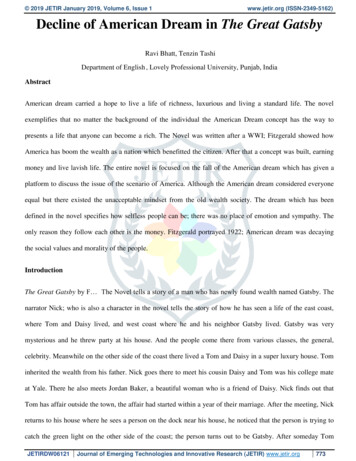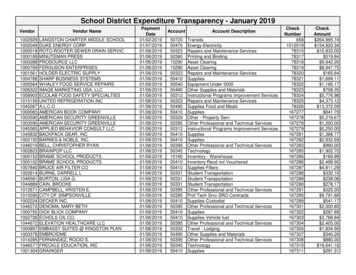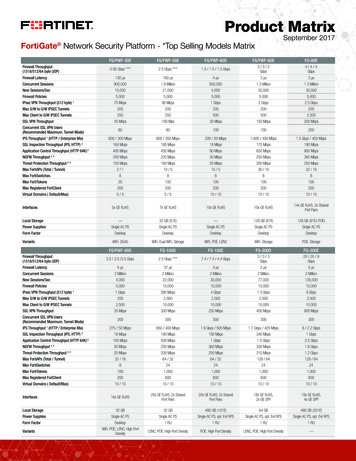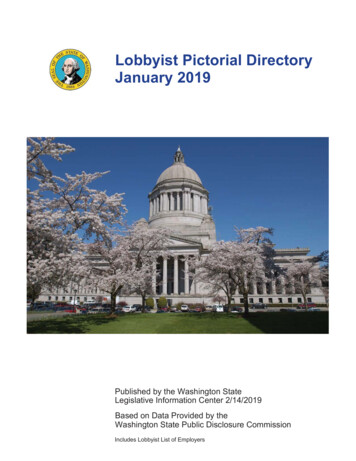
Transcription
Changing the way of learning Daily Vocab Capsule 28January 2019thExamining Farm Loan WaiversThe solution lies in better schemes that ensure universal coverage for small, marginal and medium-sized farmers.To do or not to do? According to reports, the Central government is discussing a scheme to waive outstandingfarm loans in the aftermath of widespread farmers’ protests between March and December 2018 . Till now, atleast 11 States have announced schemes to waive outstanding farm loans: Madhya Pradesh, Uttar Pradesh,Karnataka, Tamil Nadu, Maharashtra, Chhattisgarh, Punjab, Andhra Pradesh, Telangana, Assam and Rajasthan.
The pitch for waivers among States has added to the pressure on the Central government for a nationwide farmloan waiver.Divided opinionEconomists and bankers are sharply divided on whether farm loan waivers are desirable. One section ofeconomists and hard-nosed bankers argues that loan waivers represent poor policy for a variety of reasons. First,loan waivers have “reputational consequences”; that is, they adversely affect the repayment discipline of farmers,leading to a rise in defaults in future. Second, earlier debt waiver schemes have not led to increases in investmentor productivity in agriculture. Third, after the implementation of debt waiver schemes, a farmer’s access to formalsector lenders declines, leading to a rise in his dependence on informal sector lenders; in other words, waiverslead to the shrinkage of a farmer’s future access to formal sector credit.These arguments need careful and critical assessment. To begin with, there have only been two nationwide loanwaiver programmes in India after Independence: in 1990 and 2008. The accompanying image gives data onagricultural non-performing assets (NPAs) of banks before and after the 2008 waiver, and throws up twoconclusions.First, farmers are most disciplined in their repayment behaviour. In September 2018, agricultural NPAs (about8%) were far lower than in industry (about 21%). Furthermore, agricultural NPAs were on a continuous declinebetween 2001 and 2008. Second, there is no evidence to argue that the 2008 waiver led to a rise in default ratesamong farmers. The lowest of all NPAs after 2001 was recorded in March 2009 (2.1%), which was just after theimplementation of the 2008 scheme. The reason was the government’s cleaning up of the account books ofbanks. Once this was complete, it was totally expected that NPAs would rise again to settle at a slightly higherlevel. This was exactly what had happened: agricultural NPAs rose and settled at about 5% by 2011.For two reasons, the rise of agricultural NPAs, from 2% to 5%, is no evidence for indiscipline in farmerrepayment behaviour. One, NPAs in agriculture remained stable at around 4 to 5% between 2011 and 2015. Thiswas despite the fact that agricultural growth averaged just 1.5% between 2011 and 2015. Two, D. Subbarao, theformer Reserve Bank of India Governor, had pointed out in a 2012 speech that the rise in agricultural NPAsbetween 2009 and 2011 was due to the “general economic slowdown” after 2009 and the introduction of newnorms in the “system-wide identification of NPAs”.Agricultural NPAs began to rise again after 2015. There is enough evidence to suggest that this rise was not theresult of any moral hazard; it was real, policy-induced and a direct consequence of acute agrarian distress thatspread across rural India after 2015. In particular, the demonetisation of November 2016 aggravated alreadybrewing agrarian distress by sucking cash out of the rural areas, crashing output prices and disrupting supplychains.
The second argument — that loan waivers do not promote investment or raise productivity — is a bit absurdbecause nowhere has investment or productivity figured as the official objectives of these schemes. The thirdargument — that loan waivers shrink access to formal credit sector for farmers — is only partly true. But theculprits here are banks and not farmers. After every waiver, banks become conservative in issuing fresh loans tobeneficiaries, as they are perceived to be less creditworthy. For instance, a Comptroller and Auditor General(CAG) report on the waiver in 2008 found that 34.3% of the beneficiaries were not issued debt relief certificatesafter the waiver, which meant that they could not avail of a fresh loan the following year. As a result, the scheme’sobjective of expanding the issue of fresh loans to farmers was not fully achieved. But to cite such opportunisticactions of banks to deny fresh credit to farmers would be perverse policy.For every economic enterprise, it is only natural that when the bottom-line shrinks, a reduction of debt burdenbecomes inevitable. This is applicable for both (non-agricultural) firms and farms. Firms have always receiveddebt waivers, though they are tactfully termed as “loan restructuring” or “one-time settlements”. Just as for firms,farms also need a reduction of debt burden, followed by fresh infusion of credit, when their economic cycle ison a downturn. The demand for loan waivers in India is absolutely logical when viewed from such a standpoint.On the other hand, to consider loan waivers as a panacea for the agrarian distress would also be wrong. Tobegin with, access to India’s rural banks is skewed in favour of large farmers. While public banks actively servicethe credit needs of large farmers, a majority of small and marginal farmers are not proportionately included. Thelatter are forced to rely on informal sources, particularly moneylenders, for much of their credit needs. As aresult, the benefits of loan waivers accrue disproportionately to large farmers while only marginally benefitingthe small and marginal farmers.The Kerala blueprintBut is this a good reason to disallow a loan waiver scheme, as the Prime Minister suggested in a recent interview?No. The solution lies in carefully designing waiver schemes that ensure universal coverage for small, marginaland medium-sized farmers while covering both the formal and informal sources of debt. The Kerala Farmers’Debt Relief Commission Act, 2006 is an excellent model in this regard. This scheme defines debt as “any sumborrowed by a farmer from the creditor”, with the creditor defined as “any person engaged in money lending,whether under a licence or not”. The commission’s mandate included the right “to fix, in the case of creditorsother than institutional creditors, a fair rate of interest and an appropriate level of debt, to be payable ” That is,the commission could waive, reschedule or reduce any debt on a need-basis after a detailed hearing of both theparties. Legislations such as Kerala’s are blueprints to design comprehensive, inclusive and less-leaky loanwaiver schemes in other States.Finally, while loan waiver schemes are like a band-aid on a wound, it is the larger agrarian distress that demandsurgent policy attention. Unless there are steps ‘to raise productivity, reduce costs of cultivation by providing
quality inputs at subsidised rates, provide remunerative prices following the recommendations of theSwaminathan Commission, ensure assured procurement of output, expand access to institutional credit, enhancepublic investment for infrastructural development, institute effective crop insurance systems and establishaffordable scientific storage facilities and agro-processing industries for value addition’, farmers will continueto be bonded to low income equilibrium and repeated debt traps.The Hindu (Agricultural/ Economics)1. Waive (verb): To waive is to give up one's right to do something. (अस्वीकार करना, छोड़ देना)Synonyms: Relinquish, Yield, Surrender, AbandonAntonyms: Claim, Arrogate, RetainExample: The university waives the application fee for low-income students.2. Hard-nosed (adj): Practical and determined. (सख्त)Synonyms: Adamant, Dogged, Intransigent, PertinaciousAntonyms: Docile, Obedient, Acquiescent, AmenableExample: The team's hard-nosed coach doesn't make exceptions for anybody.3. Acute (adj): Extreme in degree, power, or effect. (तीव्र, तीक्ष्ण)Synonyms: Intense, Severe, Vicious, Excruciating
Antonyms: Light, Moderate, SoftExample: The problem of poverty is particularly acute in rural areas.4. Panacea (noun): A solution or remedy for all difficulties or diseases. (रामबाण, सववरोगहारी)Synonyms: Cure-All, Elixir, Nostrum, RemedyExample: Unfortunately there is no panacea that will make cancer instantly vanish from your body.5. Procurement (noun): The process of getting supplies. (उपलब्ध कराना, सरकारी खरीद)Synonyms: Acquisition, Obtainment, Purchase, AcquireAntonyms: Sell, SaleExample: Our government has substantial budget for the procurement of military supplies.6. Remunerative (adj): Financially rewarding. (लाभकारी)
Synonyms: Lucrative, Gainful, Profitable, AdvantageousAntonyms: Unprofitable, Unfavourable, DisadvantageousExample: He left to take up a more remunerative post elsewhere.7. Agrarian (adj): Relating to the land, especially the use of land for farming. (कृ षि संबंधी)Synonyms: Bucolic, Pastoral, Arable, GeorgicAntonyms: Metropolitan, Urban, IndustrialExample: India is rapidly diversifying its agrarian economy.8. Accrue (verb): To increase in number or amount over a period of time: (वृषि होना)Synonyms: Accumulate, Amass, Increase, AugmentAntonyms: Abate, Dwindle, DissipateExample: Interest will accrue on the account at a rate of seven percent.
9. Inevitable (adj): Impossible to avoid or evade. (जो टल न सके )Synonyms: Ineluctable, Ineludible, Inescapable, CertainAntonyms: Improbable, Unlikely, UnsureExample: Everyone knows death is inevitable.10. Blueprint (noun): A method worked out in advance for achieving some objective. (योजना, रूपरे खा)Synonyms: Master Plan, Design, Layout, StrategyExample: The architect’s blueprint was ready for building a new library.
Antonyms: Unprofitable, Unfavourable, Disadvantageous Example: He left to take up a more remunerative post elsewhere. 7. Agrarian (adj): Relating to the land, especially the use of land for farming. (कृषि संबंधी) Synonyms: Bucolic, Pastoral, Arable, Georgic Antonyms











